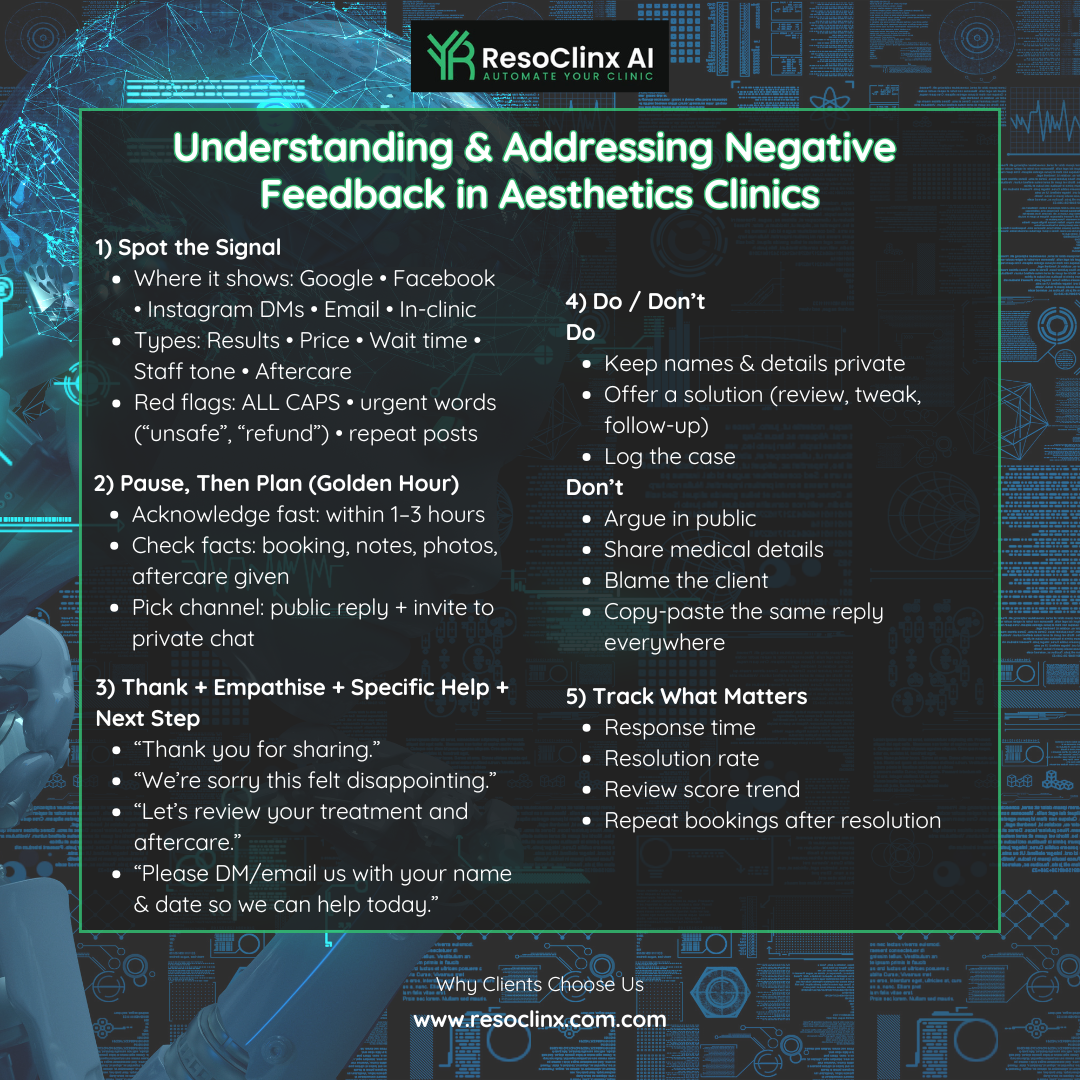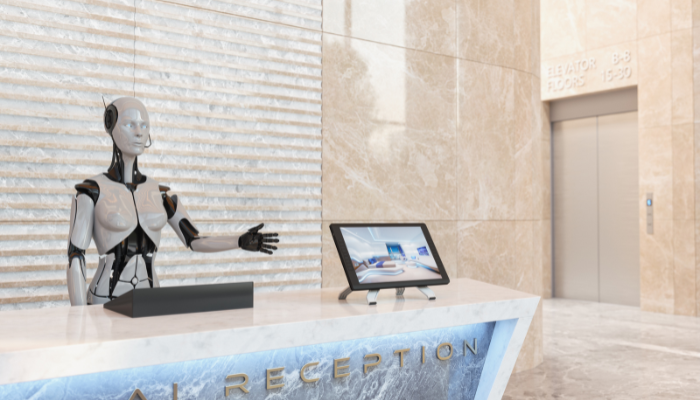Ping. A new review lands. Not the glowing kind.
Your stomach drops, your team glances over, and the questions start: Do we reply now? What do we say? Will this scare off future clients?
In aesthetics, trust is everything. One careless sentence can undo months of careful work. But the right response—calm, clear, and kind—can turn a critic into a fan and show everyone else you’re a clinic that listens.
This guide gives you ready-to-use reply templates for the most common tricky moments: pricing complaints, treatment results, long waits, and “it just wasn’t for me.” Each template is simple yet professional. You’ll also get quick tips on tone, timing, and what to avoid.
Handle negative reviews with confidence. Protect your reputation. Win back trust—one well-crafted reply at a time.
Key Takeaways
- Responding quickly and professionally to negative feedback is vital for maintaining your clinic’s image.
- Negative reviews offer a chance to improve your services and show potential clients you listen.
- Always acknowledge the patient’s experience with empathy before offering solutions.
- Keep your responses calm and avoid getting into arguments online.
- Use feedback to refine clinic operations and encourage more positive reviews from happy patients.
Understanding and Addressing Negative Feedback

It’s easy to feel a bit disheartened when a negative review pops up for your aesthetic clinic. We all want our patients to leave happy, and when they don’t, it can feel personal.
But here’s the thing: negative feedback isn’t the end of the world. In fact, it’s a really important part of running a business, especially in a field like aesthetics where patient experience is so key.
The Importance of Prompt and Professional Responses
When a less-than-glowing review appears, your first instinct might be to ignore it or, worse, get defensive. Please don’t do that. Responding quickly and professionally is absolutely vital.
It shows current and potential patients that you care about feedback and are committed to making things right.
A swift, polite response can turn a negative situation around, demonstrating your clinic’s dedication to patient satisfaction. It’s not just about appeasing the person who left the review; it’s about managing your clinic’s overall online reputation.
Turning Criticism into an Opportunity for Improvement
Think of negative reviews as free consulting. They highlight areas where your clinic might be falling short, whether that’s in service quality, communication, or even the clinic environment itself. Instead of seeing criticism as a personal attack, try to view it as a chance to learn and grow.
What can you take away from this feedback to improve your services or processes? This proactive approach can lead to significant positive changes within your practice.
Here’s a simple way to look at it:
- Identify the core issue: What specifically is the patient unhappy about?
- Assess the validity: Is this a recurring problem or an isolated incident?
- Brainstorm solutions: How can you prevent this from happening again?
- Implement changes: Make the necessary adjustments to your operations.
Every piece of feedback, good or bad, is a stepping stone. Use it to refine your patient journey and build a stronger, more trusted clinic.
How to Respond to Negative Reviews: A Strategic Approach
Responding effectively isn’t just about saying sorry; it’s about strategy. You need a plan for how you’ll handle different types of feedback. This involves acknowledging the patient’s experience, offering a clear path forward, and maintaining a consistent, professional tone across all your responses.
It’s about showing empathy while also protecting your clinic’s reputation. Remember, your response is often read by many more people than just the original reviewer.
Crafting Empathetic and Solution-Oriented Replies
When a patient shares a negative experience, it’s easy to feel defensive. However, how you respond can make a significant difference to your clinic’s reputation and future patient relationships.
The goal is to show that you’ve listened, you care, and you’re committed to making things right. Empathy and a clear path to resolution are key.
Acknowledging the Patient’s Experience
Start by validating their feelings. Phrases like “We’re so sorry to hear about your experience” or “Thank you for bringing this to our attention” show that you’re taking their feedback seriously.
It’s important to acknowledge the specific issue they’ve raised without making excuses.
For instance, if a patient mentions a long wait time, you could say, “We understand that waiting longer than expected can be frustrating, and we sincerely apologise for the inconvenience this caused during your visit.”
Offering Specific Solutions or Next Steps
Once you’ve acknowledged the problem, outline what you can do. This might involve:
- Investigating the issue: “We are looking into what happened with your appointment to understand how we can prevent this in the future.”
- Offering a direct resolution: “We would like to offer you a complimentary consultation with our senior practitioner to discuss your concerns further.”
- Inviting them to discuss offline: “To address this in more detail and find a suitable resolution, please could you contact our clinic manager, [Manager’s Name], directly at [Phone Number] or [Email Address]?”
Maintaining a Calm and Professional Tone
Even if the review seems unfair, always respond with professionalism. Avoid getting into a public debate or using overly emotional language.
Your response is not just for the reviewer but for all potential patients reading it. A calm, measured, and solution-focused reply demonstrates your clinic’s commitment to patient satisfaction and excellent service standards.
Remember, a well-handled complaint can often turn a negative situation into a positive one, showcasing your clinic’s dedication to its patients.
It’s about showing that behind every review, there’s a real person with a real experience, and your clinic is dedicated to providing the best possible care and addressing any shortcomings with grace and efficiency.
Responding to Common Negative Review Scenarios
It’s inevitable that even the most well-run clinics will occasionally receive negative feedback.
Rather than seeing these as purely damaging, think of them as opportunities to show potential clients how you handle issues.
Addressing common complaints professionally can actually strengthen your clinic’s reputation.
Addressing Service Quality Concerns
When a patient expresses dissatisfaction with the quality of service received, it’s important to acknowledge their experience directly and empathetically.
Often, a perceived lapse in service quality stems from a misunderstanding or a specific incident that doesn’t reflect your usual standards. The key is to validate their feelings without necessarily agreeing with every detail of their complaint.
- Acknowledge the specific service mentioned. Did they feel rushed? Was the outcome not as expected?
- Express regret that their experience didn’t meet their expectations. Phrases like, “We’re truly sorry to hear that your recent experience with [specific treatment/service] did not meet your expectations” can be very effective.
- Briefly reiterate your commitment to high standards. For example, “We pride ourselves on delivering exceptional results and a comfortable experience for all our patients.”
- Offer a path forward. This usually involves inviting them to discuss their concerns further offline.
“We understand that your recent visit did not align with the high standards we strive to uphold. Your feedback is important to us as it helps us to continually improve.”
Handling Complaints About Pricing or Value
Concerns about pricing or perceived value are common in the aesthetics industry.
It’s important to remember that patients are investing in themselves, and they want to feel confident they are receiving good value for their money.
Your response should be informative and transparent.
- Acknowledge their comment on pricing. You could say something like, “We appreciate you sharing your thoughts on the pricing of our treatments.”
- Explain your pricing structure briefly. Mention that your prices reflect the quality of products used, the expertise of your practitioners, and the advanced technology employed.
- Highlight the value and results. Focus on the benefits and outcomes patients can expect, such as the skill of your team, the safety protocols, and the long-term satisfaction.
- Suggest a consultation. This allows you to discuss individual needs and tailor treatment plans, demonstrating personalised value.
Responding to Feedback on Waiting Times or Clinic Environment

Issues related to waiting times or the clinic’s atmosphere can significantly impact a patient’s overall experience.
These are often operational challenges that can be addressed with clear communication and a commitment to improvement.
- Apologise for any inconvenience caused. “We sincerely apologise for the longer than usual wait time during your recent visit.”
- Provide context if appropriate, but avoid making excuses. For instance, “We occasionally experience unexpected delays due to the complex nature of some treatments, and we are always working to minimise these.”
- Outline steps being taken to improve. This shows you’re actively working on the issue. For example, “We are reviewing our scheduling system to better manage appointment flow and reduce waiting times.”
- Reassure them about the clinic environment. If the feedback is about the environment, mention efforts to maintain a clean, comfortable, and relaxing space.
It’s always a good idea to track the types of negative feedback you receive. This can help identify patterns and areas where operational adjustments might be needed.
For example, if multiple reviews mention long waits on a specific day, you might need to re-evaluate staffing or appointment scheduling for that period.
Leveraging Reviews for Enhanced Reputation Management
Think of your online reviews as a living, breathing part of your clinic’s reputation. They’re not just comments; they’re conversations that potential patients are watching.
Actively managing and responding to them is key to building trust and showing you care.
Encouraging Positive Reviews from Satisfied Patients
It’s easy to focus on the negative, but don’t forget about your happy clients. They are your best advocates. A simple, timely request after a successful treatment can make a big difference.
Consider implementing a system that gently prompts patients for feedback via email or SMS a few days after their appointment.
This proactive approach helps to capture positive experiences before they fade.
- Automated review requests: Use your patient management system to send out review prompts.
- In-clinic prompts: Train your reception staff to ask satisfied patients to leave a review.
- QR codes: Display QR codes at reception or on feedback forms that link directly to your review pages.
Using Feedback to Refine Clinic Operations
Every piece of feedback, good or bad, is a chance to learn and improve. When you see a recurring theme in reviews, whether it’s about waiting times or a specific treatment, take it seriously.
This information is gold for identifying areas that need attention. For instance, if multiple reviews mention long waits, it might be time to review your scheduling or staffing levels.
Regularly analysing your reviews can highlight operational bottlenecks you might otherwise miss. This data-driven approach allows for targeted improvements that benefit both your patients and your clinic’s efficiency.
Showcasing Your Commitment to Patient Satisfaction
Responding to reviews isn’t just about damage control; it’s about demonstrating your commitment to patient satisfaction.
When you publicly acknowledge feedback and show how you’ve addressed concerns, it sends a strong message. This transparency builds confidence and can even turn a negative experience into a positive impression of your clinic’s customer service.
Your active engagement with feedback is a powerful tool for reputation management.
Best Practices for Online Review Interaction
Engaging with online reviews is a bit like having a conversation with your clients in public. It’s important to be polite, helpful, and professional, even when the feedback isn’t glowing.
Think of each review as a chance to show potential clients how you handle things.
When to Take the Conversation Offline
Sometimes, a review touches on sensitive personal details or complex issues that can’t be fully addressed in a public comment. In these situations, it’s best to move the discussion to a private channel.
A simple way to do this is to acknowledge the review publicly and then invite the client to contact the clinic directly.
- Acknowledge the feedback publicly: “Thank you for sharing your experience, [Client Name]. We’re sorry to hear that your visit didn’t meet your expectations.”
- Offer a direct contact: “Please could you reach out to our clinic manager, [Manager Name], at [Phone Number] or [Email Address] so we can discuss this further and find a resolution?”
- State your goal: “We value your feedback and would like to understand more about your visit to help us improve.”
This shows you’re taking their concerns seriously without airing all the details online.
Avoiding Defensive or Argumentative Responses
It’s natural to feel a bit defensive when you read a negative review, especially if you feel it’s unfair. However, responding with anger or defensiveness will only make the situation worse and reflect poorly on your clinic.
Always aim for a calm, measured, and professional tone.
Here’s a quick guide to help you stay on track:
- Pause and Breathe: Before you type a single word, take a moment to step away from the review. Let any initial emotional reaction pass.
- Focus on Facts: Stick to what you know about the situation. Avoid making assumptions or getting drawn into personal attacks.
- Empathise (Even if you disagree): Try to see the situation from the reviewer’s perspective. Phrases like “We understand your frustration” can go a long way.
- Offer Solutions, Not Excuses: Instead of explaining why something went wrong, focus on what you can do to make it right or prevent it from happening again.
Remember, your response isn’t just for the person who left the review; it’s for everyone else who reads it. A professional response can turn a negative situation into a positive impression.
The Role of AI in Streamlining Review Management

Managing online reviews can be time-consuming, especially for busy clinics. This is where AI tools can be incredibly helpful.
AI can assist in several ways:
- Monitoring: Automatically track new reviews across various platforms.
- Categorisation: Help sort reviews by sentiment (positive, negative, neutral) or by topic (service, staff, facilities).
- Drafting Responses: Generate initial drafts for common types of feedback, which you can then review and personalise.
- Identifying Trends: Analyse large volumes of reviews to spot recurring issues or areas of excellence.
Using AI doesn’t mean you stop being human in your interactions.
It simply frees up your time so you can focus on providing thoughtful, personalised responses where they matter most, and allows you to quickly address feedback without getting bogged down in manual processes.
It helps maintain a consistent presence and shows clients you’re actively listening.
Template Responses for Various Feedback Types
Even with the best intentions, sometimes things don’t go quite as planned, and patients might leave feedback that isn’t glowing.
Having a few go-to templates can really help you respond professionally and constructively. It shows you’re listening and that you care about the patient experience.
Template for Minor Dissatisfaction
This is for those reviews where a patient is a bit unhappy about something small, like a slight delay or a minor point about the service.
Dear [Patient Name],
Thank you for taking the time to share your feedback about your recent visit to [Clinic Name]. We’re glad to hear you were happy with [mention something positive if possible, e.g., the results of your treatment].
We’re sorry to hear that [mention the specific minor issue, e.g., your waiting time was longer than expected]. We understand how frustrating this can be, and we’re looking into ways to improve our scheduling to minimise these delays.
We appreciate you bringing this to our attention and hope to welcome you back for a smoother experience soon.
Kind regards,
The Team at [Clinic Name]
Template for Significant Service Issues
When a review highlights a more serious problem, like a misunderstanding about a treatment or a significant issue with the service provided, a more detailed response is needed.
Dear [Patient Name],
Thank you for reaching out and sharing your experience. We are very concerned to read about the issues you encountered during your visit on [Date] regarding [specific service/issue]. Please accept our sincerest apologies for falling short of the high standards we set for ourselves and that you rightly expect from us.
We take feedback like yours very seriously. To help us understand this better and address it properly, we would like to invite you to discuss this further with our clinic manager, [Manager’s Name], at your earliest convenience. Please contact us directly at [Phone Number] or [Email Address] so we can arrange a suitable time.
Our priority is to ensure every patient feels heard and well-cared for, and we are committed to making this right.
Sincerely,
[Your Name/Clinic Management]
Template for Misunderstandings or Factual Errors
Sometimes, reviews might contain inaccuracies or misunderstandings about pricing, procedures, or policies. It’s important to clarify these points politely and factually.
Dear [Patient Name],
Thank you for your review. We appreciate you sharing your thoughts on your experience at [Clinic Name].
We wanted to gently clarify a point mentioned in your feedback regarding [specific point, e.g., the cost of the treatment]. Our pricing for [specific treatment] is [state the correct price or explain the pricing structure]. This was outlined in the consultation and consent forms provided.
We strive for complete transparency with all our patients, and we’re always happy to discuss any aspect of your treatment or our pricing in more detail. Please feel free to call us if you have any further questions.
We value your feedback and hope this clarification is helpful.
Best regards,
The Team at [Clinic Name]
Turning Feedback into Future Success
Negative reviews don’t have to define your clinic—they can show your standards.
Use the templates, reply quickly, keep your tone calm, and invite the client to continue the chat privately.
Document what you learn, adjust your process, and let future readers see a team that listens and improves. Ready? Copy a template, tailor it to your voice, and turn a tough moment into a trust win.
Frequently Asked Questions
Why is it important to respond to negative reviews?
Replying to negative feedback shows you care about your patients’ experiences. It also gives you a chance to fix things and shows potential new clients that you’re a responsible clinic that listens and improves.
How should I respond to a negative review?
Always stay calm and polite. Thank the person for their feedback, acknowledge their experience without making excuses, and offer to discuss it further privately. This shows you're taking their concerns seriously.
What if the review isn't true?
Even if you think the review is unfair, respond politely. Stick to the facts calmly. You can gently correct misinformation, but avoid getting into an argument. It's often best to offer to talk about it offline.
Should I offer a discount or refund in my response?
Sometimes, offering a solution like a follow-up appointment or a partial refund can resolve the issue. However, don't offer these in the public reply. Suggest discussing it privately to find a suitable solution.
How can I encourage more positive reviews?
Simply ask satisfied patients to leave a review. You can send a polite follow-up message after their appointment or have a simple system in place, like a QR code at reception, to make it easy for them.
When is it okay to take the conversation offline?
It's always best to take detailed or sensitive discussions offline. If a review involves personal details, complex issues, or requires a specific solution, invite the patient to contact the clinic directly via phone or email.






